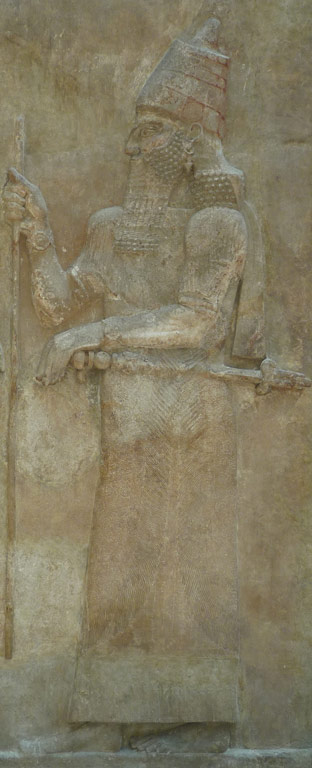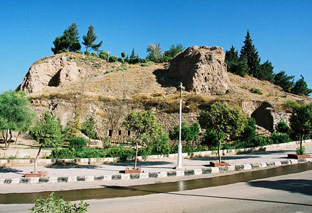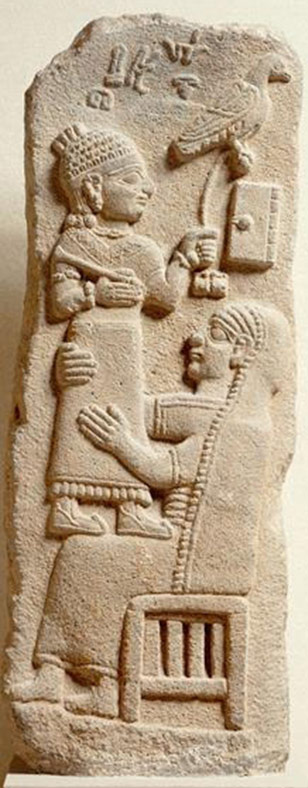Sargon II, king of Assyria (721-705 BC)
Sargon II ascended to the Assyrian throne in the midst of a countrywide rebellion. He built a lavish new residence city, Dur-Šarruken, but died on the battlefield just one year after its completion.

Sargon was not the chosen successor of his father Tiglath-pileser III (744-727 BC) but took the throne by force from his brother Shalmaneser V (726-722 BC), the former crown prince Ululayu whose reign lasted barely five years.
Sargon was already middle-aged when he came to power: he must have been at least forty years old and had at least one adult son, Sennacherib, who from the start of his father's reign assisted him in running the empire as crown prince. As a son of Tiglath-pileser, we might expect to find Sargon attested in a prominent military or administrative role in the archival materials from Kalhu dating to his father's reign but, as we do not know under what name he was known before he took the crown of Assyria, he has not yet been identified.
His throne name means "the king is true" and one of his inscriptions explains in detail the political programme behind this choice: "My name, which the great gods assigned to me in order to uphold law and justice, to help the powerless prevail and to protect the weak". Sargon portrayed himself as the restorer of order, but did he rescue the country from a state of lawlessness under his brother or was the chaos caused by a coup which he himself had engineered in order to win the crown? The few available sources do not allow us to decide this matter.
Rebellion!
The new king met with massive opposition in the Assyrian heartland as well as further away. The centre of insurgence in the west of the Assyrian empire was the city of Hamat PGP where one Yau-bi'di gained widespread support: the former kingdoms of Hamat, Arpad PGP , Damascus PGP and Israel all rose in rebellion in the aftermath of Sargon's rise to power but he managed to crush the revolt in 720 BC. Hamat was destroyed once again and 6,300 "guilty Assyrians", people from the heartland whose lives Sargon had decided to spare but whom he exiled from the empire's centre in northern Iraq, found themselves moved to its ruins, repaying their merciful king by rebuilding this once proud city.
As central Assyria and the west rose in rebellion against the new king, Assyria's enemies in the south saw their chance: Merodach-baladan, chief of the powerful Bit-Yakin tribe and the leading figure of the anti-Assyrian movement in Babylonia, announced the end of Assyrian sovereignty and claimed the throne of Babylon for himself. Sargon reacted to this provocation by marching his troops southwards and Merodach-baladan retaliated by joining forces with the king of Elam PGP , Assyria's rival of old. Together they mustered a massive army against Sargon's forces. In 720 BC, the troops met in battle at the city of Der PGP in the plains east of Babylon, on the very same battlefield where, almost two centuries later (539 BC), Dareios the Great would defeat the army sent by the last Babylonian king, Nabonidus, to repel the Persian invasion. Although Merodach-baladan's troops arrived too late for active combat, the Assyrian army was pushed back by his Elamite allies and he retained control of the south and the title of king of Babylon.

Filling Sargon's coffers: the plunder of Carchemish and Muṣaṣir
After this rocky start, and the loss of the Babylonian crown, Sargon was able to consolidate his rule in Assyria and his son Sennacherib, as crown prince, assumed a very responsible role in the running of the state.

The conquest of Carchemish PGP in 717 BC allowed Sargon to compensate for the costs of the permanent and intensive deployment of the army since the beginning of his reign. The small but wealthy kingdom of Carchemish was situated in a key position in the trade network: controlling an important Euphrates crossing, it was positioned at a crossroads between the Mediterranean coast, Anatolia and Assyria and profited from its role in international trade. Moreover, Carchemish was the ideological heir of the Hittite Kingdom of the second millennium BC, lending its king a leading role among the Syrian and Anatolian kingdoms that occupied the lands formerly under Hittite control. When Sargon attacked, he violated existing treaties with the venerable Assyrian ally, claiming that Pisiri, king of Carchemish, had betrayed him to his enemies. Carchemish could not offer much resistance to the Assyrian army. The prize was its treasury, including more than 60 tonnes of silver, huge amounts of bronze, tin, iron and ivory and 330 kilos of purified gold. The influx of silver permanently changed the Assyrian economy from a bronze-based to a silver-based financial system which relied on silver according to the standard of Carchemish.
The capture of the holy city of Muṣaṣir PGP three years later was similarly motivated by its wealth, rather than by the treachery of its king Urzana, the pretext used by Sargon to justify his actions. By the time Sargon plundered the shrine and the royal palace in 714 BC, the temple of Haldi, revered since at least the late 3rd millennium BC, had been receiving gifts and donations for centuries. This resulted in a loot of more than a tonne of gold and about ten tonnes of silver, as well as masses of other treasure.
Dur-Šarruken - "Sargon's Fortress"
This hefty addition to his finances enabled Sargon to begin the construction of Dur-Šarruken, "Sargon's Fortress", in 713 BC. In contrast to (see Kalhu, and also the later capital city of Nineveh, this was an entirely new city, constructed on virgin soil in an area quite close to Kalhu which Sargon had identified as the perfect site for the centre of the Assyrian empire.

It was a gigantic building project, intended to be the king's crowning achievement. In the foundation inscriptions excavated at the site, Sargon proudly takes credit for recognising the potential of the sleepy village of Maganubba as the location for his new residence city; he bought the land from its owners, emphasising that he paid the market rate, and started a massive irrigation project which was to provide water for the agriculture needed to sustain the inhabitants of what was to be the largest city in Assyria, with an area of almost three square kilometres.
Dur-Šarruken's ground plan is modelled on that of Kalhu but while the latter city was developed from an existing settlement (a fact reflected in its layout), Sargon's new capital was perfectly symmetrical with no concern for the surrounding landscape. The two gigantic platforms, one housing the palace and the temples and the other housing the arsenal, were constructed from scratch. The seven monumental city gates penetrated the fortification wall at regular intervals, their locations not dictated by the needs of a pre-existing road network. Sargon's new palace eclipsed the buildings of all his predecessors in scale and quality. The relief scenes that adorned the palace walls depict his conquests and also the sack of Muṣaṣir which had contributed so crucially to the funding of the building works; today, they can be admired in the Louvre (Paris) and in the Iraq Museum (Baghdad). Only eight years after the work had begun, in 706 BC, the court moved to Dur-Šarruken. By that time, the most prominent features of the project were finished, although building work still continued elsewhere.
Sargon's triumph and death
 [http://tinyurl.com/o2h6z9]
[http://tinyurl.com/o2h6z9]Sargon continued the policy of conquest and annexation that had already characterised the reigns of Tiglath-pileser III and Shalmaneser V, but the effort to control areas that were situated ever farther away from the Assyrian heartland began to weigh heavily. Two provinces in the Zagros Mountains PGP were created in 716 BC but were only held after years of fighting; deportations from the region brought a sizeable Median population to the city of Assur, a fact which may have played a role in the city's fall in 614 BC. The attempt to establish the province of Tabal PGP in central Anatolia in 713 BC was doomed and had to be terminated after a bloody rebellion in the following year - a first in Assyrian imperialism. However, the annexation of the Philistine kingdom of Ashdod in 711 BC was successful, as were the conquest and integration of the Neo-Hittite states of Gurgum and Kummuhhu (Commagene) in the same year and in 708 BC respectively.
But Sargon's most significant triumph occurred in 710 BC when he finally managed to oust Merodach-baladan from the Babylonian throne, taking the crown of Babylon for himself; while his crown prince Sennacherib officiated in Kalhu, Sargon spent the next three years residing in Babylon, receiving homage and gifts from rulers as far away as Cyprus and Bahrain. He came back to central Assyria only when the court was ready to move to Dur-Šarruken.
In 705 BC, Sargon returned to Tabal in an attempt to restore the region to its former status as an Assyrian province. His army met with violent opposition and, shockingly, the king died in battle, his corpse lost to the enemy - a catastrophic event which led to the abandonment of Dur-Šarruken as the royal residence and was later thought to lie at the root of his heirs' bad fortune: Sennacherib (704-681 BC) was murdered while the reign of Esarhaddon (681-669 BC) was haunted by conspiracy and illness.
Further reading
- Frahm, 'Nabû-zuqup-kenu, das Gilgamesch-Epos und der Tod Sargons II.', 1999.
- Fuchs, 'Sargon II.', 2009.
- Lanfranchi, 'Consensus to empire: some aspects of Sargon II's foreign policy', 1997.
- Parpola, 'The construction of Dur-Šarrukin in the Assyrian royal correspondence', 1995.
- Thomas, 'Sargon II., der Sohn Tiglat-pilesers III.', 1993.
- Younger, 'Recent study on Sargon II, king of Assyria: implications for Biblical studies', 2002.
Content last modified: 8 Aug 2012.
Karen Radner
Karen Radner, 'Sargon II, king of Assyria (721-705 BC)', Assyrian empire builders, University College London, 2012 [http://www.ucl.ac.uk/sargon/essentials/kings/sargonii/]